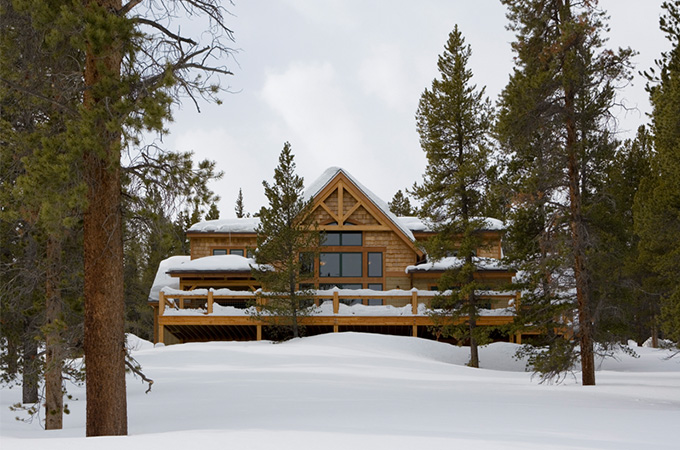
Woodhouse has long been known for its commitment to providing energy efficient and sustainable timber frame homes for its clients. We accomplish this goal through sustainability efforts such as our use of structural insulated panels (which qualify for Energy Star certification) and utilizing passive solar energy orientation whenever possible. We also use the most energy efficient windows available for our custom Woodhouse timber frame homes.The windows you choose for your home can have an impact on your heating and cooling costs. Considering that the window isn’t much more than a deliberate hole in the wall where energy can escape, it may not be surprising that the average home loses approximately 30% of its heat or cooling through the windows. While the payback period of energy efficient window units can range from just two years to ten years, the financial benefit is certainly worth the extra consideration.
The term “U-value” refers to the rate at which windows lose heat. This heat loss occurs in four different ways: Radiation is the term used to describe the infrared heat energy that passes through the glass of the window. Conduction is the direct loss of heat through the window from indoors to outside. Convection is the term used when the heat from the air is captured by the cooler glass, making the now cool air sink to the floor. This causes a cycle of new warm air being sucked toward the glass and cooled. This can cause an uncomfortable draft-like feeling. Air Leakage is simply the loss of warm air through cracks and outlets to the outdoors.
When choosing energy efficient windows for your home, there are a lot of things to consider. You’ll want to make sure your window panes are energy efficient, but you also need to think of the frame, since it accounts for 25% of the window’s area. Wood and vinyl frames are the most thermally nonconductive and the most readily available. Stay away from aluminum frames if energy efficiency is a goal, as they can be poor energy performers.
Wood frames are usually the most expensive frame material. They also need regular maintenance, as they tend to rot and shrink over time. Vinyl frames are energy efficient, weather resistant, durable, and won’t rot. However, their colored exterior may fade with time, and the frame may become brittle and thermally unstable. One big downfall is that vinyl tends to expand and contract through changes in temperature, which has the potential for future air leakage. A new trend in the window framing industry is the fiberglass frame. It is extremely durable, and the frames can expand at the same rate as the glass pane, which is a unique feature to fiberglass. The pros and cons must be weighed heavily when choosing one of these framing materials, but a good alternative to these frames are clad versions, as they are easy to maintain.
We feel that clad windows are the best option for our timber frame homes. Both aluminum clad windows by Eagle and vinyl clad windows by Andersen have earned our highest recommendation for your energy efficient windows.
Aluminum clad windows (like the ones Eagle makes) contain a wood interior with extruded aluminum encasing it in such a way that it gives the look and feel of an entirely wooden window frame, while providing added durability and a smooth and sleek look. The Eagle brand windows we use in our custom timber frame homes come in a plethora of color options. There are 50 base colors to choose from, but you have the option to customize them any way you’d like. Check out the endless possibilities for the Eagle windows in your timber frame home at www.eaglewindow.com. Vinyl clad frames from Andersen are also a great option, and come in a variety of styles and options as well. Another great feature of these clad windows is that they require no painting or finishing. They’re ready to be installed in your home as-is.
Energy efficient window glazing helps stop winter condensation. When the cold temperature of the glass causes the air around it to reach its dew point, the water beads up and condensates on the window. The edges of the window are always colder, so that’s where the condensation will begin.
Low-E coatings work in both heating and cooling climates, depending on which pane they are applied to. In warming climates, the coating should be applied to the internal surface of the interior pane, so that the heat is reflected back to the interior. In cooling climates, the coating should be applied to the inter-pane surface of the exterior pane, so that heat energy is reflected back outside to keep hot summer air from coming inside.
High performance Low-E4 glass is one of the best options. Andersen Low-E4 glass is used in our pre-designed timber frame home packages. It is up to 41% more energy efficient than ordinary dual-pane glass, provides excellent UV filtration, noise reduction, and increased drying time, and it stays clean longer than typical window glass.
Both Eagle and Andersen windows provide a huge selection of energy efficient windows. They are the premier choice for our Woodhouse timber frame packages. Of course Woodhouse’s goal is and always has been customer satisfaction, so clients are encouraged to choose the energy efficient window that suits their needs the best.
Energy Efficient Timber Frame Home Plans From Woodhouse
If you’d like more information about the energy efficient options Woodhouse can provide for your new timber frame home, give us a call at 800-227-4311 and we’d be happy to go over the endless options.